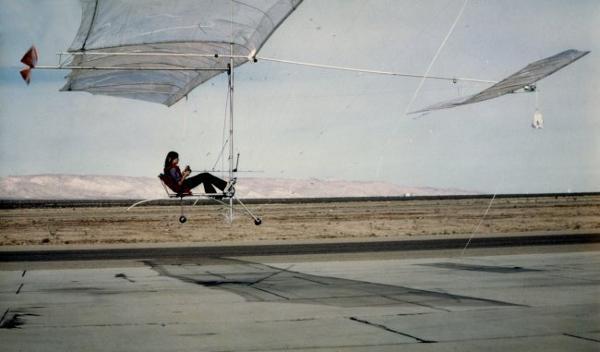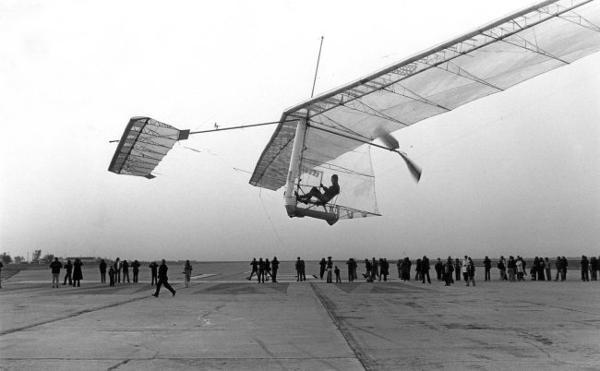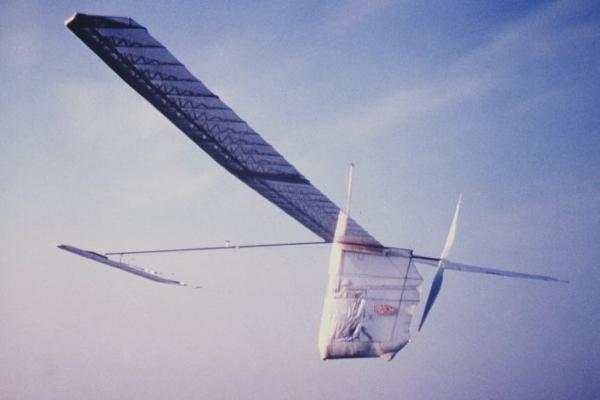The Gossamers
GOSSAMER CONDOR.
Until now, all human powered aircraft had followed the glider and the bicycle. There had been nothing really new since the 1935 Mufli of Haesller and Villinger. Designers had added to this by copying wheel drive from the bicycle, which meant unnecesary weight once airborne. HPA had flown in straight lines, but the Mufli had flown in a straight line. Every time the straight line got a little longer we got excited, but the 2290 yards (2094 m) of the Stork compared with the 779 yards (712 m) of Mufli? In forty years one expects more progress than that. And no HPA could repeatably demonstrate controlled sustainable turns. There must be a better way.
As this account shows, the quantum leap in HPA progress made by the Gossamer series occurred through a combination of novel ideas and thorough analysis, as well as iteration through flight testing and modifications.
In 1976 experienced glider-pilot and aerodynamicist Dr Paul MacCready decided to follow the hang-glider concept. His first calculations showed that with a much larger wing area than other HPA, flying speed could be brought so low that the drag of wire-bracing would be permissible. Also, at this low speed, wheel drive for take-off would not be needed.
PASADENA VERSION
MacCready decided that as a first step he would make the simplest possible machine to just fly and prove the principle. This would look like no other aeroplane, in fact it would look like no other thing at all. It consisted of 12 ft (3.66 m) lengths of 2 inch (50.4 mm) diameter aluminium tube and a network of wires. If it didn't work, MacCready didn't want to be laughed at; if it did work he wanted to keep it secret. So if anyone asked what "that" was he replied "This is a work-of-art. It portrays the meddling of government in the affairs of citizens". This first test aircraft flew just once in the car park of the Pasadena Rose Bowl, California, near where it had been made by Jack Lambie.
MOJAVE VERSION
The first real aeroplane had a single surface Mylar covered aerofoil, the aluminium spar tube at the leading edge with a second tube near the trailing edge, no pilot fairing, but otherwise the general configuration of the later versions. First flight was at midday on 26th December 1976 in the Mojave desert. Pilot was one of Paul MacCready`s sons. They had been taking turns to get their breath back on the initial runs and hops and stated later that "Who is to say what is a real flight, so who can say who made the first one". Best that day was a 40 second flight, already exceeding the durations of many previous HPA. The plane was named Gossamer Condor to draw attention to the condor, an endangered species of bird native to the locality. This aeroplane had a wing-span of 96 ft (29m) and an area of 1100 sq ft (102.2 m2). Longer flights were made and enough experience gained to show that the plane could not be made to turn. Also it was unstable, but the motions were so slow that all pilots could cope with this. Initially, the canard stabilizer only worked as an elevator to control pitch. Later it was made to bank, so that it would " pull the plane round by the nose ".

The first 40 second flight of the Mohave version of the Gossamer Condor, Dec 26, 1976, Parker MacCready pilot. RAeS collection
SHAFTER VERSION
An improved version flew at Shafter airport, California in March 1977. Shafter had calmer weather at this time of year, and nearby lived Vern and Maude Oldershaw, Sam Duran, Bryan Allen and Bill Richardson. The team were able to draw on Dr Chester Kyle's experience with human-powered road vehicles. A special aerofoil was designed by Dr Peter Lissaman. This has a low pitching moment and moderate concavities. It has been used on several subsequent planes built by others, ( see Table of Types). At this stage it would seem that the plane was never quite the same shape on any two flights as a variety of lateral control surfaces were tried out. Spoilers were tried, then a forward rudder, then an aft rudder. The banking canard stabilizer on its own was insufficient. Before long, the Gossamer Condor's total time in the air had exceeded that of all other HPA put together. Minor crashes were frequent; if the spar broke the pilot would jump out, so as to land feet-first and to reduce the weight on the plane. If anything broke it was rebuilt better. The Condor was evolving from the initial contraption into a sophisticated flying machine. While the team were still searching for a method of making the plane turn controllably, it was so severely damaged as to require a rebuild. They promptly started thinking about what improvements to incorporate in the next version.
Final configuration of the Shafter version of the Gossamer Condor. Bryan Allen piloting, which made the Kremer Prize flight August 23, 1977. Copyright Don Monroe
WASHOUT
Many wings are built with a twist such that at each wing-tip the angle of attack is the same as at the other tip, but different from the angle of attack at the centre of the wing. This is known as wash-out or wash-in.
While discussing wash-out for the new Gossamer design to replace the damaged machine, someone said as a joke that if the wing had wash-out on one side and wash-in on the other then at least it would turn, which is what they couldn`t make it do any other way. Then the serious practicable application of this bizarre idea dawned on others present. The new version incorporated a lever in the cockpit which when operated pulled on the rigging wires. This action twisted each wing. The system worked as hoped for in flight. The pilot retained the use of the banking stabilizer for small corrections and the wing-twist was used both to initiate and to hold a steady turn. This and all other HPA until then had done little more than straight flights, unsuccessfully trying all sorts of lateral-control-devices except, until then, this wing-warping which, in fact, was the system which the Wright brothers had used. But a bright idea is not enough: MacCready then had to calculate how much twist would be required. With Bryan Allen as pilot, an attempt was soon made on the Kremer figure of eight course with a prize of £50,000 to be won. On the first attempt the wake from a passing crop-duster plane put the aeroplane out of action. On Bryan's next attempt on the 23rd August 1977 the course was completed. The first Kremer Prize, that had been known as 'the' Kremer Prize’ for eighteen years had been won. The Gossamer Condor was now flown for the fun of it by all members of the team and others including Professor Geoffrey Lilley of Southampton, England.
KREMER CROSS CHANNEL COMPETITION
Henry Kremer's response to the first figure-eight flight was promptly to propose a new challenge, and the rules for the Channel crossing were drafted by a sub-committee chaired by Ron Moulton. Also there was to be a new figure-eight competition, restricted to entrants from any country other than that of the first winner. As mentioned above, after the first flights of SUMPAC and Puffin, it was generally thought that it would be a short time before the figure eight was flown. This was not what happened. When a competition was announced with the course being the English Channel, then it was generally thought that it would be a long time before this course was flown, if it ever was. "22 miles?", "Impossible !". Again, this is not what happened.
GOSSAMER ALBATROSS
The project started in October 1977 as a development of the Condor. New materials would lighten the weight. The technique of producing carbon-fibre tubes was developed. Although carbon-fibre had been used for some time, and composite tube structures were used for instance for fishing-rods, this was the first time that carbon was used on tubes of the proportion that we now think of as HPA spar proportions. Kevlar, another material taken for granted today, was used on an HPA first on the Albatross.
The wing surface profile was improved by having closer spaced ribs. The wing area was reduced to suit a higher speed. First flight of the Albatross was at Shafter in July 1978.
HPF>HPA
Human powered flight entails more than just a human powered aircraft. MacCready was realising that the organisational problems involved were such that sponsorship would be needed. In March 1979 the Du Pont Company, makers of most of the materials of the plane, agreed to be chief sponsor. The publicity generated by MacCready's ingenious use of their new material Kevlar resulted in millions of pounds of extra business for the firm.
Organisational tasks included :- transport to England of the plane and two back-up planes, test-flying these over land, obtaining boats, studying navigation, providing communications and making arrangements for the team during the trip which might last several months waiting for the right weather. The aeroplane was refined but was still not indicating the capability of crossing the English Channel, as Bryan Allen's best duration was 18 minutes. It was considered that inefficiency in the propeller was holding them back. With help from the Chrysalis team (see below), Gossamer Albatross soon had a new propeller, and in April 1979 Allen's duration improved from 18 minutes to 69 minutes, and he was not exhausted. He landed only to let Kirk Giboney have a flight. At this time, the intention was that the next stage would consist of some practice flights over water, but in a way that at the time seemed to the team to be magic, with the aid of test pilots and Royal Air Force authorities whom they had never met, transport to England had been arranged for the very next day in a Royal Air Force Hercules. So the overwater testing was skipped. It was some weeks before the weather was right but on the 12th June 1979 at 5.51 am the Gossamer Albatross with Bryan Allen aboard headed out to sea, with the many escort boats. Part way across, the plane met a headwind. It had been anticipated that the first attempt might not get all the way, hence the spare aeroplanes, but Allen kept pedalling. Although France can be seen from the top of the Dover cliffs, it cannot be seen from the beach. This means that for almost half the trip Bryan Allen was pedalling apparently to nowhere, but following MacCready in the pilot boat. Then comes the moment when it can be realised that that blur on the horizon is the continent, which gradually gets firmer.
The headwind was getting stronger and when barely three miles from Cap Gris Nez , Allen felt he could go on no longer and it was decided to abort the flight. The first move was made in the pre-planned procedure, namely climb to the height of a fishing-rod ready to be hooked up for a tow from a fast rubber dinghy. Surprisingly, he found that at this greater height he was able to proceed, so he never made the hook-up and flew all the way under his own power, arriving at 8.40 am, feeling that he could not have gone another 100 yards. But the Channel had been crossed, and the prize won by a superhuman effort, the equivalent of a marathon race in the air.
Back in England to collect the reserve aircraft, MacCready kindly invited all those of us known to be interested in HPF in England to view these aeroplanes; and he then related the background to the achievement. (See Gossamer Odyssey).
Gossamer Albatross flying the English Channel on 12th June 1979. RAeS collection
